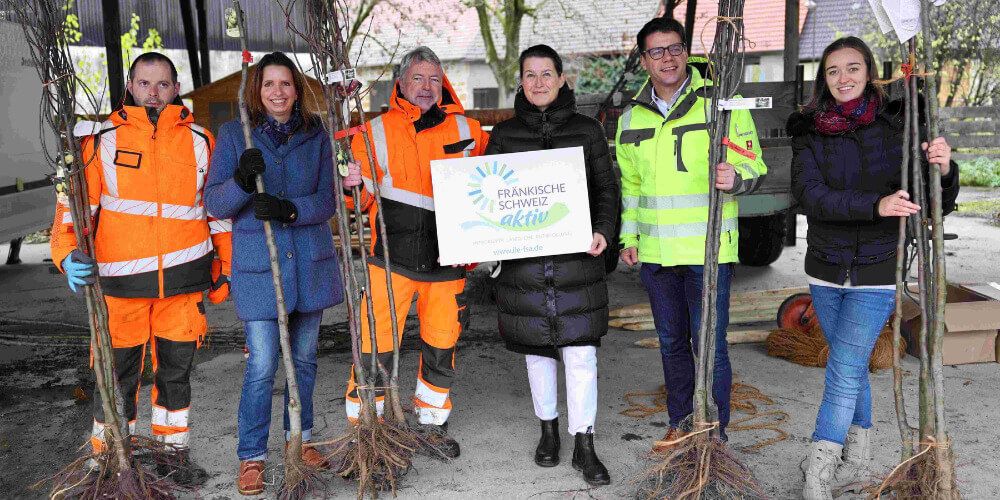Großer Erfolg: Streuobstpakt fördert 2.400 Bäume in den 12 Kommunen der ILE Fränkische Schweiz AKTIV

Das Ziel der Bayrischen Staatsregierung, 1 Mio. zusätzliche Streuobstbäume zu pflanzen, ist einen wichtigen Schritt weitergekommen: In diesem Jahr wurden dank dem Streuobstpakt 1.700 Obstbaumbestellungen durch die Integrierte Ländliche Entwicklung Fränkische Schweiz AKTIV realisiert und für das nächste Jahr sind bereits 700 Bäume vorbestellt.
Am Freitag, 24. November 23 erfolgte die Ausgabe der Bäume in den 12 ILE-Kommunen.
Anlässlich des Stadtjubiläums nutzte die Stadt Ebermannstadt den Streuobstpakt, um Obstbäume an Einheimische zu verschenken.
„Wir freuen uns sehr über diese große Resonanz“, resümiert Christiane Meyer, die 1. Bürgermeisterin der Stadt Ebermannstadt und 1. Vorsitzende des kommunalen Vereins ILE Fränkische Schweiz AKTIV, „wir wurden regelrecht überrannt von dem großen Interesse und bedauern es sehr, dass wir nicht alle Bestellungen in diesem Jahr berücksichtigen konnten. Wir werden daher sehr gern auch im kommenden Jahr den Streuobstpakt unterstützen und haben alle, die in diesem Jahr leer ausgegangen sind, automatisch für das kommenden Jahr vorgemerkt.“
Gemeinsam mit dem ILE-Management haben die 12 Kommunen der ILE Fränkische Schweiz AKTIV den Streuobstpakt umgesetzt. Hauptpartner hierfür war die Baumschule Schmitt aus Poxdorf, die rund 1.200 Bäume liefern konnte. Rund 500 weitere Obstbäume wurden von der Baumschule Wagner aus Poxdorf geliefert. Die Koordination der einzelnen Bestellungen übernahmen die jeweiligen Kommunen.
„Dies ist ein wichtiger Beitrag, um die Artenvielfalt in der Fränkischen Schweiz zu fördern und zu erhalten und er reiht sich ein in viele Projekte rund ums das Streuobst“, freut sich Thomas Müller, Leiter der Abteilung Land- und Dorfentwicklung beim Amt für Ländliche Entwicklung. Hand in Hand mit dem ILE Management Corinna Brauer und Julia Petschler fördert das Amt für Ländliche Entwicklung die Umsetzung des Streuobstpaktes. „Wir sind sehr dankbar für diese unbürokratische Förderung, die gerade bei Privatpersonen auf großes Interesse gestoßen ist“, erläutert Corinna Brauer und Julia Petschler ergänzt: „Einziger Wermuttropfen ist, dass wir leider nicht alle Bestellungen in diesem Jahr bedienen konnten, 700 Baumbestellungen haben wir auf das kommende Jahr verschoben, da die Bäume erst nachwachsen müssen. Wir sind sicher, dass der Streuobstpakt auch in den kommenden Jahren bei unseren Einheimischen sehr beliebt sein wird“.
Mit dem Streuobstpakt möchte die Bayerische Staatsregierung zusammen mit vielen Partnern aus Verbänden und Wirtschaft bis zum Jahr 2035 die Pflanzung von einer Million neuer Streuobstbäume fördern. Hierfür wurde das Förderprogramm „Streuobst für alle“ gestartet. Gefördert wird der Kauf hochstämmiger Obstgehölze mit bis zu 45 Euro der Bruttokosten pro Baum. Als Eigenanteil bleiben lediglich die Aufwendungen für das Pflanzmaterial (wie Wühlmausschutz, Pflock oder Strick).
Die Förderung kann über Kommunen sowie über Vereine organisiert werden. Diese nehmen Sammelbestellungen auf, übernehmen die Online-Antragstellung, und koordinieren die Aus- und Weitergabe der Bäume.
Für Rückfragen:
Corinna Brauer & Julia Petschler ILE Fränkische Schweiz AKTIV e. V., Kirchenplatz 2, 91320 Ebermannstadt, Telefon: 0160-89 38 207, E-Mail: corinna.brauer@ile-fsa.de



